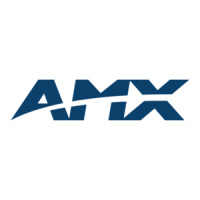Displaying Stream Content
133
Modero VG Series Touch Panels - Instruction Manual
Displaying Stream Content
Overview
The current build of Modero firmware currently supports the display of both MPEG-2 and MPEG-4 media streams via the TPDesign
touch panel pages. These incoming media signals can utilize either a UDP or RTP Transport protocol. For the purposes of these
instructions, we will be setting up a Modero touch panel to display an incoming media stream sent from a MAX Video Encoder. To
fully utilize both MPEG-2 and MPEG-4 streaming functionality, you must be using the latest Modero firmware.
MAX-CSE Media Encoder can currently stream A/V signals and direct them to IP-enabled devices capable of interpreting and
displaying the incoming MPEG data using either RTP or UDP Transport Protocols. These outgoing signals can be displayed by a:
VG-Series Modero Touch Panel (supporting MPEG-2/MPEG-4 streams)
Computer running third-party multi-media player capable of supporting UDP/RTP streaming protocols.
At this time, we are recommending using the open-source VLC Media Player
®
(version 0.8 or higher).
Supported transport protocols include: UDP or RTP.
A protocol is a convention or standard that controls or enables the connection, communication, and data transfer between two
computing endpoints. In this case, between the MAX-CSE and the target IP-capable device (Modero).
NOTE: IP Multicasting is supported under both the UPD and RTP communication protocols. If using RTP, it is strongly recommended
that this port number be an even value. Using an odd numbered port value can cause the stream from a MAX-CSE to not be properly
recognized by the target Modero panel.
UDP (User Datagram Protocol) is a connectionless protocol, such as TCP, that runs on top of IP networks. Unlike TCP/IP,
UDP/IP provides a direct way to send and receive datagrams over an IP network. It's primarily used for broadcasting
messages over a network. Data is sent as a Transport Stream by using only the MPEG-2 codec.
In a UDP stream, only a Target (video) Port is needed since both the audio and video information are transported together
to the same port on the destination device.
RTP (Real-Time Transport Protocol) is an Internet protocol used for transmitting real-time data such as audio and video as
separate entities. Data is sent as an Elementary Stream which can use both the MPEG-2 and MPEG-4 codecs.
In an RTP stream, both a Target (video) Port and Target Audio Port are required because the audio and video are delivered
to a destination as separate data elements. These elements are then directed to two separate ports where they are then
"synced-up" by target device/application.
NOTE: If using RTP, both the Target Port and Target Audio Port must be different.
IP Multicasting is a method of sending out large amounts of data. IP Multicast allows a server to broadcast a message to
many recipients simultaneously. Unlike traditional Internet communication, that requires separate connections for each
source-destination pair, IP Multicasting allows several recipients to share data from the same source. This means that just
one set of packets is transmitted to all the destinations.
An ideal method of sharing a single stream to several destinations.
One of the best uses for this method would be if an educator (or institution) wanted to stream (via either UDP or RTP) its lecture
series to a variety of students simultaneously around the world. Every student could connect and receive the stream without having
to wait their turn to view the content or see a severe drop in transmission quality.
Requirements for Receiving Streamed Content
To receive and display content via a Modero panel:
Verify you have installed the latest version of TPDesign4 on your PC. Updates are available from the www.amx.com > Te ch
Center > Application Files > Touch Panel Design Tools section of the website. This application is needed to create the
necessary page (popup page) used to display the incoming MPEG audio/video stream, identify the IP of the source MAX-
CSE, and def ine the target audio/video ports on the panel.
Verify you have installed the latest firmware on your target Modero panel. Updates are available from the www.amx.com >
Tec h C en te r > Firmware Files > Modero Panels section of the website. Modero VG-Series firmware version 2.55.12 or
earlier only supports MPEG-2 streaming media (using UDP). MPEG-4 is only supported by the VG-Series Modero panel
firmware version 2.60.25 or higher.
NOTE: If using RTP (as both the Target Port and the Target Audio Port for the split stream), it is strongly recommended that this
port number be an even value. Using an odd numbered port value will cause the stream to not be properly recognized by the
target Modero panel. When using Modero f irmware version 2.60.25 (or higher), a UDP Transport Protocol can use either odd or
even ports.
It is necessary to understand that Modero firmware is configured to look for audio on a port whose value is two greater
than that set for the video port. When configuring the Target Video and Target Audio ports within the MAX-CSE’s UI Stream
Profiles page, the value entered into the Target Au dio field must be exactly 2 above the value entered into the Target Port
(video) field.
If you enter a Ta rge t Port value of 5000, when using RTP, you must enter a value of 5002 into the Targ et Audio Por t field.
If using UDP, only the Target Por t (video) field is user-definable because both the video and audio are sent out by the CSE
as one stream and therefore there is no reason to define a separate audio port. Entering a value of 5000 into this field will,

